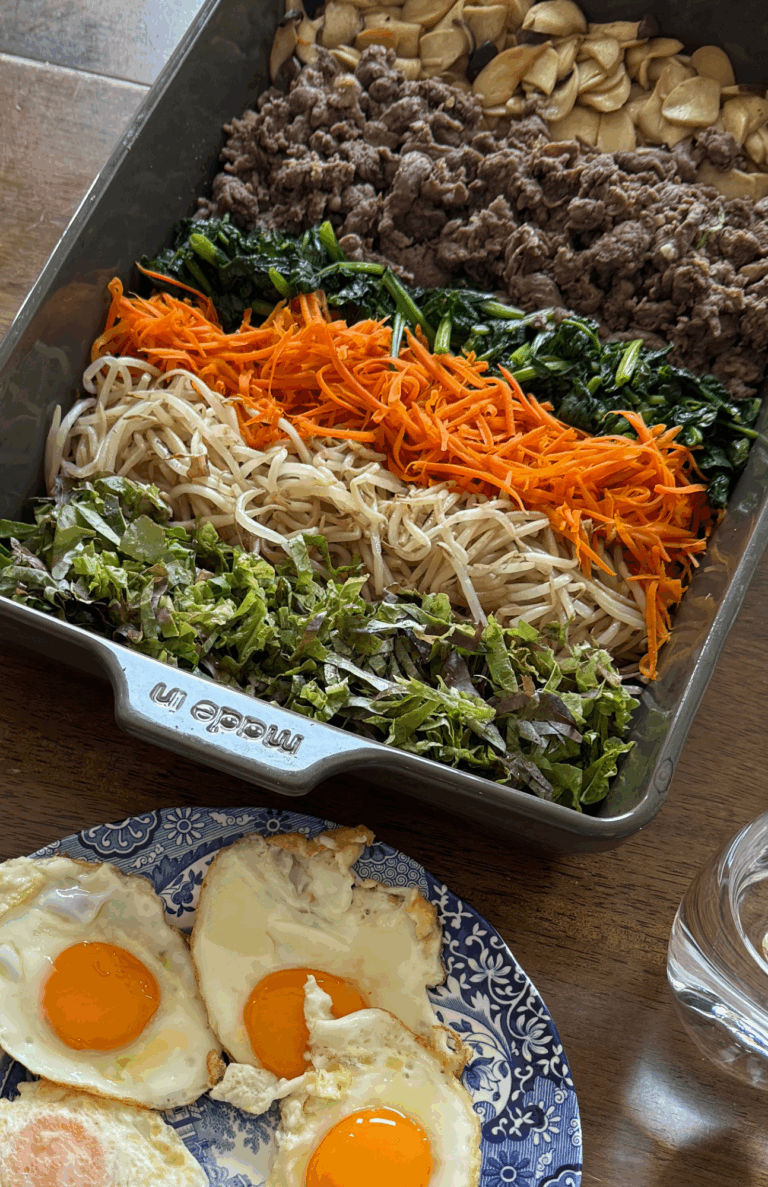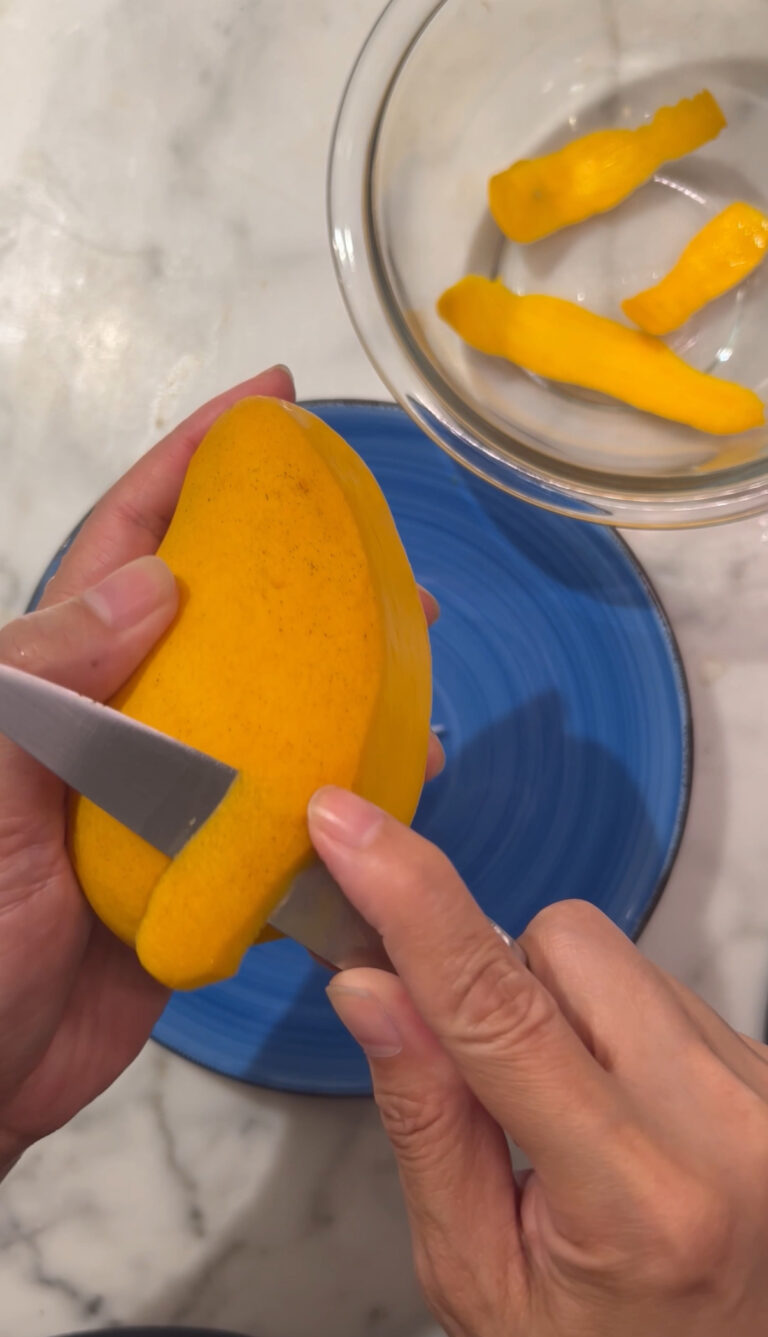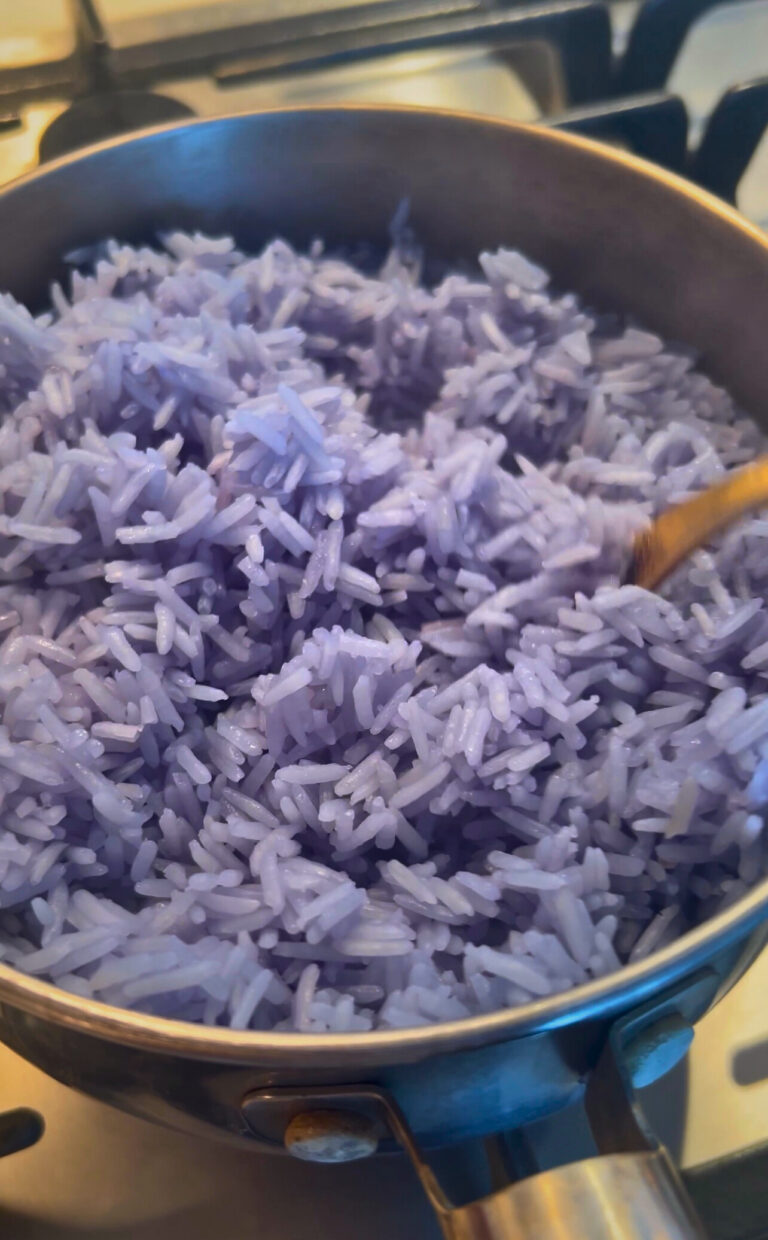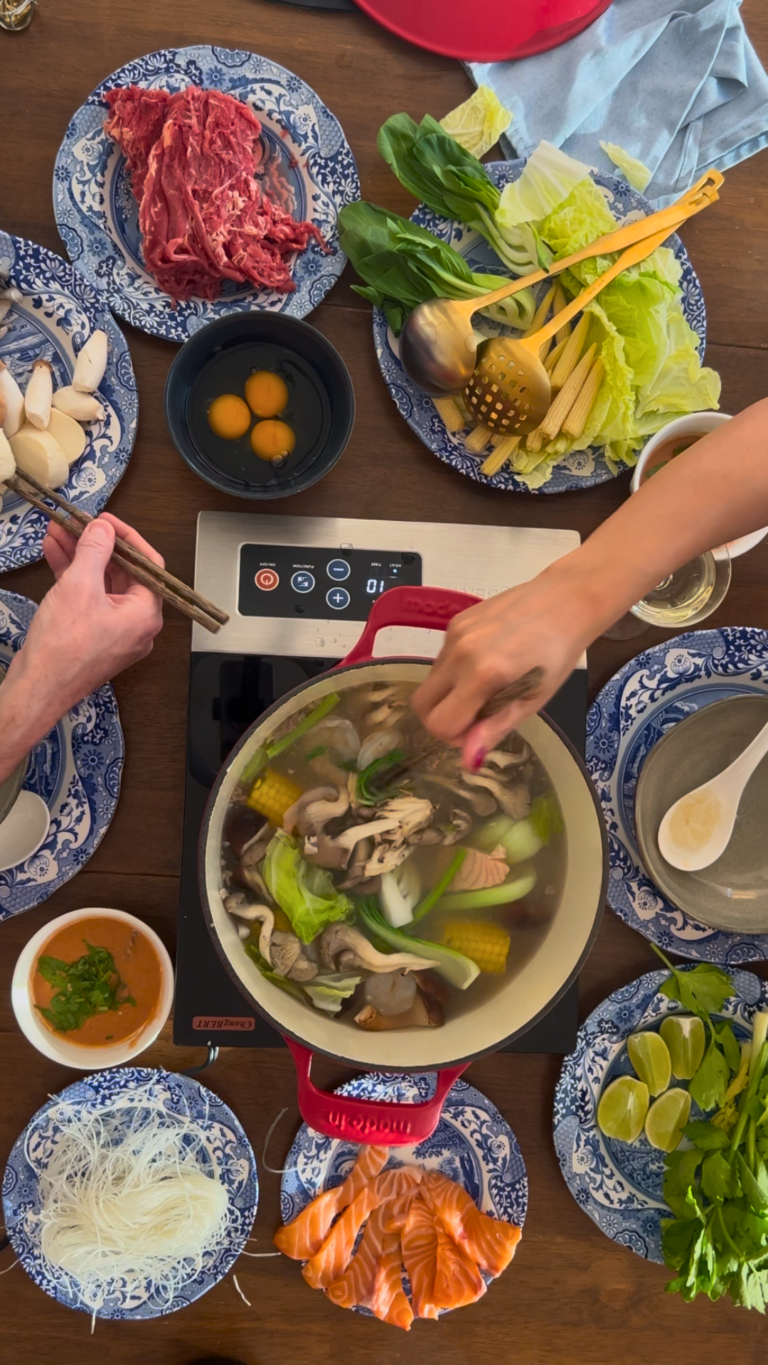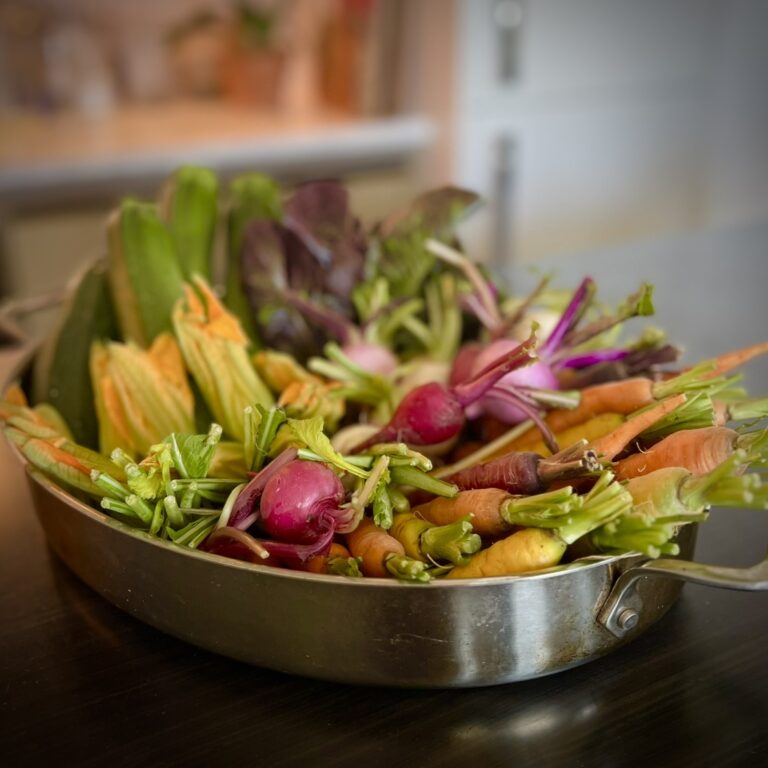10 Tips For Cooking Healthy, Tasty Food
Healthy eating doesn’t mean giving up on flavor or creativity!
As a Chef, I’ve learned that the secret to eating and cooking healthier lies in choosing the right ingredients, the techniques you use, and adding a dash of culinary flair.
Whether you’re trying to build better habits or simply elevate your meals, this guide will show you how to make cooking and eating healthier a delightful experience.
1. Only Use Fresh, Whole Ingredients
Healthy cooking starts with the quality of your ingredients. Whole, minimally processed foods retain more nutrients and natural flavors, forming the base of delicious, healthy meals.
How to Eat Healthier
Good Fruits:
- Berries: High in antioxidants like anthocyanins, which reduce inflammation and protect against chronic diseases such as heart disease and cancer. They’re also low in calories and high in fiber for better digestion.
- Apples: Rich in soluble fiber (pectin) that supports gut health, helps regulate blood sugar, and promotes a feeling of fullness. They also contain quercetin, an antioxidant that boosts immunity.
- Oranges: Packed with vitamin C, which supports immune function and skin health. They also contain potassium, essential for heart health and blood pressure regulation.
- Bananas: High in potassium, which supports muscle and nerve function, and natural sugars for a quick energy boost. They also contain prebiotic fibers that feed healthy gut bacteria.
Grapes: Contain resveratrol, an antioxidant that supports heart health and reduces inflammation. They’re also hydrating and provide natural energy.
Healthy Vegetables:
- Spinach: Loaded with iron for energy production, vitamin K for bone health, and folate for brain function. It’s also low in calories and versatile for various dishes.
- Broccoli: A cruciferous vegetable rich in sulforaphane, a compound linked to cancer prevention. It’s high in fiber and vitamin C, boosting digestion and immune health.
- Bell Peppers: High in vitamin C (even more than oranges!) and beta-carotene, which supports skin, eye health, and immunity. Their bright colors indicate a variety of antioxidants.
Carrots: Rich in beta-carotene, which the body converts into vitamin A for healthy vision and immune support. They’re also naturally sweet, making them a great low-calorie snack.
Lean Proteins:
- Skinless Chicken Breast: Low in saturated fat and high in protein, supporting muscle repair and growth. It’s also a versatile ingredient for healthy meals.
- Turkey: A great source of lean protein, low in fat, and rich in tryptophan, which supports serotonin production for better mood and sleep.
- Eggs: Packed with high-quality protein, vitamins B12 and D, and choline, which supports brain health and development. They’re also budget-friendly.
- Tofu: A plant-based protein rich in iron and calcium, making it a great meat alternative. It contains isoflavones, which may support heart and bone health.
- Legumes (like lentils, chickpeas, and beans): High in fiber and plant-based protein, they help regulate blood sugar, support gut health, and reduce cholesterol levels.
Whole Grains:
- Quinoa: A complete protein (contains all 9 essential amino acids) and a great source of magnesium, which supports muscle and nerve function.
- Oats: High in beta-glucan, a soluble fiber that helps lower cholesterol and regulate blood sugar. They’re also heart-healthy and keep you full longer.
Brown Rice: Contains more fiber and nutrients than white rice, including B vitamins, magnesium, and antioxidants. It provides sustained energy.
Why Avoid Certain Foods:
- Packaged Chips and Sugary Cereals: High in unhealthy fats, added sugars, and empty calories, contributing to weight gain and increasing the risk of chronic diseases like diabetes and heart disease.
Frozen Meals with Preservatives: Often loaded with sodium and artificial additives, which can increase blood pressure and cause bloating. They also lack the nutrients found in fresh, whole foods.
How to Cook Healthier
Use Fresh Herbs Instead of Packaged Seasonings:
- Why Fresh Herbs Are Better:
Fresh herbs like basil, cilantro, and dill are packed with antioxidants, vitamins, and minerals without the added sodium, sugar, or preservatives found in seasoning mixes. For example:- Basil: Contains eugenol, an anti-inflammatory compound.
- Cilantro: Rich in vitamin K, which supports blood and bone health.
Dill: Contains flavonoids that may reduce the risk of heart disease.
Buy Seasonal Fruits and Vegetables:
- Why Seasonal Produce is Healthier:
- Seasonal fruits and vegetables are fresher, meaning they retain more nutrients. They’re also less likely to be treated with preservatives or pesticides during long shipping processes.
- For example, in summer, enjoy watermelon and zucchini for hydration and light meals. In winter, turn to root vegetables like sweet potatoes for warming dishes rich in beta-carotene.
By incorporating these foods and habits, you’ll not only improve your diet but also enjoy the benefits of better energy, immunity, and long-term health.
2. Master the Art of Portion Control
Eating mindfully is the cornerstone of enjoying meals without overindulging. By mastering portion control, you can appreciate every bite while maintaining a balanced diet and avoiding unnecessary calories.
How to Eat Healthier:
- Use the “Plate Method”:
- Fill 50% of your plate with colorful, non-starchy vegetables (e.g., leafy greens, broccoli, bell peppers).
- Allocate 25% to lean protein like chicken, fish, tofu, or beans.
- Reserve 25% for whole grains such as quinoa, brown rice, or whole-grain pasta.
- Pre-Portion Snacks:
- Divide nuts, trail mix, or popcorn into small snack-size bags to avoid mindless overeating.
- Opt for individual servings of yogurt, hummus, or fruit instead of eating straight from a large container.
- Be Mindful of Hunger Cues:
- Eat slowly and stop when you feel satisfied, not stuffed.
- Wait 10 minutes before reaching for seconds to assess whether you’re still hungry.
How to Cook Healthier:
- Serve Individual Portions:
- Plate meals in individual bowls or plates rather than serving family-style to limit the temptation to overeat.
- Pre-Pack Balanced Meals:
- Prepare lunch containers in advance with a mix of lean proteins, vegetables, and grains for portion-controlled, grab-and-go meals.
- For example, fill a container with grilled chicken, roasted sweet potatoes, and steamed broccoli.
- Use Smaller Plates and Utensils:
- A smaller plate makes portions look more satisfying and reduces the likelihood of overeating.
- Use smaller utensils to encourage slower eating and better digestion.
By embracing portion control, you can enjoy a wide variety of foods without overindulging, making every meal a satisfying and nourishing experience.
3. Cook with Healthy Fats
Not all fats are created equal! Healthy fats are essential for a balanced diet, adding richness and satisfaction to meals while supporting heart, brain, and overall health. Incorporating these fats into your cooking can elevate both flavor and nutrition.
How to Eat Healthier with Healthy Fats:
- Good Fats to Include:
- Olive Oil:
- Rich in monounsaturated fats and antioxidants, olive oil supports heart health and reduces inflammation.
- Example: Use it as a salad dressing base, drizzle over roasted vegetables, or dip whole-grain bread into it with herbs.
- Avocados:
- Packed with monounsaturated fats, fiber, and potassium, avocados help lower bad cholesterol (LDL) and improve good cholesterol (HDL).
- Example: Add sliced avocado to sandwiches, mash it into guacamole, or blend it into smoothies for creaminess.
- Almonds:
- High in vitamin E, magnesium, and heart-healthy fats, almonds are great for snacking or cooking.
- Example: Use almond butter as a spread, or sprinkle slivered almonds on salads, oatmeal, or yogurt.
- Walnuts:
- A great source of omega-3 fatty acids, walnuts support brain function and heart health.
- Example: Add them to baked goods, mix into trail mix, or toss into a grain salad.
- Flaxseeds:
- Rich in omega-3s, lignans (antioxidants), and fiber, flaxseeds promote heart and digestive health.
- Example: Sprinkle ground flaxseeds on oatmeal, blend into smoothies, or mix into baked goods like muffins.
- Olive Oil:
- Incorporate Fatty Fish:
- Fish like mackerel, sardines, salmon, and tuna are rich in omega-3 fatty acids, which reduce inflammation and support brain and heart health.
- Example: Grill salmon with a squeeze of lemon and dill, or use canned sardines as a protein-packed addition to salads or toast.
How to Cook Healthier with Healthy Fats:
- Drizzle Olive Oil Over Roasted Vegetables:
- Olive oil enhances the flavor of roasted vegetables while delivering heart-healthy fats.
- Example: Toss broccoli, carrots, or zucchini with olive oil, garlic, and rosemary before roasting.
- Replace Sour Cream with Avocado or Greek Yogurt:
- Both alternatives provide a creamy texture and nutrients without the saturated fat in sour cream.
- Example: Blend avocado with lime juice and spices for a taco topping, or use Greek yogurt in place of sour cream in dips, dressings, or baked potatoes.
- Make Homemade Salad Dressings:
- Avoid store-bought dressings with unhealthy fats by making your own using olive oil, lemon juice, balsamic vinegar, or tahini.
- Example: Whisk together olive oil, Dijon mustard, and apple cider vinegar for a tangy, heart-healthy dressing.
- Use Healthy Fats for Cooking or Baking:
- Replace butter with coconut oil in baked goods for a tropical flavor, or use avocado oil for high-heat cooking due to its high smoke point.
- Example: Stir-fry vegetables in avocado oil or use coconut oil in banana bread recipes.
- Snack on Healthy Fats:
- Swap chips or candy for snacks like roasted chickpeas, a handful of almonds, or avocado slices on whole-grain crackers.
Why Healthy Fats Matter:
- They provide essential fatty acids the body can’t produce on its own.
- Support absorption of fat-soluble vitamins (A, D, E, K).
- Promote satiety, reducing cravings and overeating.
- Reduce inflammation, lower bad cholesterol, and support brain function.
By integrating these healthy fats into your meals, you can enjoy richer, more satisfying dishes while reaping the health benefits they bring.
4. Maximize Veggies in Every Meal
Vegetables are packed with vitamins, minerals, and fiber. Making them the star of your meals is an easy way to boost nutrition.
How to Eat Healthier:
- Add greens like spinach or arugula to sandwiches or wraps.
- Include a side salad with every meal, topped with nuts or seeds for crunch.
How to Cook Healthier:
- Stir-fry veggies with ginger, garlic, and soy sauce for a quick and healthy side.
- Spiralize zucchini or carrots as a pasta alternative.
5. Swap Refined Grains for Whole Grains
Whole grains are nutrient-dense powerhouses, offering more fiber, vitamins, and minerals than refined grains. They provide sustained energy, support digestion, and help you feel fuller for longer, making them an essential part of a healthy diet.
How to Eat Healthier with Whole Grains
- Start Your Day with Whole Grains:
- Swap sugary cereals for a hearty bowl of oatmeal topped with fresh fruit, nuts, and a drizzle of honey for natural sweetness.
- Experiment with other breakfast grains like amaranth or millet porridge for added variety.
- Incorporate Grain Blends:
- Mix whole grains like quinoa, wild rice, and barley for side dishes or salads. Their varied textures and flavors add depth to your meals.
- Try bulgur wheat or farro as a base for grain bowls or pilafs.
- Replace Refined Grains in Snacks:
- Opt for popcorn instead of chips—it’s a whole grain and can be flavored with herbs and spices for a healthier snack.
- Choose whole-grain crackers or rice cakes for dips and spreads.
How to Cook Healthier with Whole Grains
- Enhance Flavor by Toasting Grains:
- Toast grains like farro, quinoa, or millet in a dry pan before cooking to bring out their nutty, rich flavor.
- Toasting can also reduce bitterness in grains like quinoa by removing their natural coating, saponin.
- Use Whole-Grain Breadcrumbs:
- Replace regular breadcrumbs with whole-grain versions in recipes like meatballs, veggie patties, or coatings for baked chicken or fish.
- Swap Refined Pasta and Rice for Whole Grains:
- Replace white rice with brown rice, wild rice, or a blend of the two for added texture and nutrients.
- Use whole-grain pasta for dishes like spaghetti or mac and cheese to make them more filling and nutritious.
- Bake with Whole Grains:
- Replace all-purpose flour with whole-wheat or spelt flour in baked goods like muffins, pancakes, and breads.
- Add oats to cookies or energy bars for a fiber boost.
Why Choose Whole Grains?
- Fiber-Rich: Promotes better digestion and helps maintain healthy cholesterol levels.
- Nutrient-Dense: Whole grains are packed with B vitamins, magnesium, and iron.
Slow Energy Release: Their complex carbohydrates provide sustained energy and help regulate blood sugar levels.
Pro Tips to Maximize Whole Grain Use
- Batch Cook Grains: Cook extra quinoa, farro, or brown rice to use in meals throughout the week, like salads, stir-fries, or grain bowls.
- Explore New Grains: Try lesser-known options like teff, freekeh, or sorghum to keep your meals exciting and nutritious.
- Go for Whole-Grain Snacks: Choose whole-grain granola bars, crackers, or baked goods for quick and wholesome snacking.
By incorporating whole grains into your meals, you’ll not only enhance the flavor and texture of your dishes but also enjoy the numerous health benefits they bring.
6. Reduce Sugar Without Losing Sweetness
I have sweet tooth. I do. The idea of cutting sugar scares me sometimes but I have learned it’s possible. I have been practicing this since last summer and it works. Cutting back on sugar doesn’t mean sacrificing flavor or giving up dessert! It’s about embracing natural, healthier alternatives that satisfy your sweet tooth while supporting your overall health. Small changes can make a big difference in reducing added sugar in your diet.
How to Eat Healthier by Reducing Sugar
- Snack on Naturally Sweet Foods:
- Enjoy fruits like dates, figs, or frozen grapes, which provide natural sweetness along with fiber and essential nutrients.
- Opt for dried fruit without added sugar as a portable and satisfying snack.
- Upgrade Your Yogurt Game:
- Choose plain yogurt and top it with fresh berries, sliced bananas, or a drizzle of honey for natural sweetness.
- Add a sprinkle of nuts or granola for crunch and texture.
- Choose Naturally Sweet Beverages:
- Skip sugary sodas and flavored drinks; instead, go for infused water with citrus, berries, or cucumber.
- Replace sugary teas with herbal teas like chamomile or hibiscus, which have a natural hint of sweetness.
How to Cook Healthier by Reducing Sugar
- Use Natural Sweeteners in Baking:
- Replace refined sugar with mashed bananas, unsweetened applesauce, or pureed dates in baked goods like muffins or cookies.
- Experiment with honey, maple syrup, or coconut sugar, or date sugar which are less processed and bring a unique flavor and nutrients.
- Make Fruity Desserts:
- Bake or grill fruits like apples, pears, or peaches with a dash of cinnamon for a naturally sweet treat.
- Blend frozen bananas into a creamy, sugar-free “nice cream.”
Why Reduce Sugar?
- Improved Energy Levels: Reducing sugar helps avoid energy spikes and crashes, keeping you energized throughout the day.
- Better Heart Health: Cutting back on sugar can help lower blood pressure and reduce the risk of heart disease.
- Reduced Cravings: Natural sweetness helps break the cycle of overconsumption and promotes mindful eating.
Pro Tips for Reducing Sugar
- Read Labels: Look for hidden sugars in packaged foods and opt for unsweetened versions when possible.
- Gradual Reduction: Slowly reduce the sugar in your coffee, tea, or recipes to help your taste buds adjust.
- Embrace Whole Foods: Whole fruits and vegetables contain natural sugars balanced with fiber and nutrients, making them better for your health.
By using these tips, you can enjoy sweetness in your meals and desserts while nourishing your body and cutting out unnecessary sugars. It works with me and I hope it will do magic for you too.
7. Try New Cooking Techniques
The way you cook your food can significantly impact its nutritional value and flavor. By experimenting with healthier cooking techniques, you can retain more nutrients, cut back on unnecessary fats and calories, and elevate the taste of your meals. Most of all, I think it’s truly fun and satisfying to cook for yourself.
How to Eat Healthier with Better Cooking Techniques
- Choose Grilling Over Frying:
- Grilled chicken, fish, or veggies provide a smoky, charred flavor without the added oils and fats from frying.
- At restaurants, opt for grilled or baked options to make healthier choices.
- Swap Creamy for Light:
- Choose broth-based soups over cream-based ones for a lighter, more nutrient-rich option.
- Use pureed vegetables like carrots, sweet potatoes or cashews as a base for creamy-textured soups without the added cream.
- Focus on Steaming and Poaching:
- Steaming vegetables preserves their natural flavors and nutrients, making them a healthier alternative to boiling.
- Poach proteins like fish or eggs for a delicate texture with minimal added fat.
How to Cook Healthier by Trying New Techniques
- Roasting for Rich, Caramelized Flavors:
- Roast vegetables like Brussels sprouts, carrots, and sweet potatoes at high heat to enhance their natural sweetness and develop a crispy texture. Try this recipe.
- Toss with olive oil, salt, and pepper, and add fresh herbs or spices for extra flavor.
- Stir-Frying for Quick, Nutrient-Preserving Meals:
- Use a wok or a large skillet to stir-fry vegetables and lean proteins quickly over high heat. This method locks in nutrients while maintaining a crisp texture.
- Add a splash of Thaimee all purpose sauce for a quick stir fry dish, it’s your secret weapon in your kitchen.
- Grilling for Smoky Depth:
- Grill meats, seafood, or veggies for a low-fat, high-flavor option. Marinate ingredients with olive oil, herbs, and spices to enhance flavor without adding calories.
- Air-Frying for a Healthier Crunch:
- Use an air fryer to replicate the texture of fried foods with minimal oil. Perfect for crisping up vegetables, chicken, or even snacks like chickpeas. If you don’t have an air fryer at home, you can utilize your oven as well.
- Sous Vide for Precision Cooking:
- This technique involves vacuum-sealing food and cooking it slowly in a water bath at a precise temperature. It locks in moisture and flavor without the need for added fats. I promise I will talk more about this technique later in depth.
Why Try New Techniques?
- Nutrient Retention: Methods like steaming, stir-frying, and roasting help preserve vitamins and minerals in your food.
- Flavor Boost: Techniques like grilling and roasting naturally enhance the taste of your ingredients without heavy sauces or added salt.
Health Benefits: Choosing lighter cooking methods reduces unhealthy fats and calories, supporting better heart health and weight management.
Pro Tips for Exploring Techniques
- Start Small: Experiment with one new technique each week to find what works best for your lifestyle and palate. Have fun with it and try not to feel intimidated. Cooking is not rocket science. The more you practice, the more you will get better results.
- Invest in Tools: Consider investing in quality pot and pans. From my experience, it makes a big difference. If you can’t afford a whole set, start small. Remember, health is wealth. Another tools that I like and believe it’s worth it is a steamer basket. Finally, if you can, an air fryer is a great option to invest in especially if you love frying food. YOu don’t need to have everything at once but build them in time as you grow your repertoire.
By exploring these healthier cooking methods, you can create meals that are both delicious and nourishing.
8. Prep ahead for success.
Meal prepping is a game-changer for maintaining a healthy lifestyle. By preparing meals and snacks in advance, you save time, reduce stress, and make it easier to stick to healthier choices throughout the week. A little planning can go a long way in setting yourself up for success.
How to Eat Healthier with Meal Prep
- Stock Up on Easy Snacks:
- Keep boiled eggs, pre-cut fruits, and veggie sticks (like carrots, celery, or bell peppers) in the fridge for grab-and-go options.
- Portion nuts, trail mix, or roasted chickpeas into snack-sized bags or containers for quick and nutritious snacks.
- Plan Breakfast in Advance:
- Freeze individual smoothie packs by pre-portioning fruits, greens, and seeds into zip-top bags. Just add liquid and blend for a quick, healthy breakfast.
- Prepare overnight oats in jars with toppings like berries, nuts, and cinnamon for a ready-to-eat morning meal.
- Batch Cook Basics:
- Roast a big tray of vegetables or cook a batch of brown rice or quinoa to use in various meals throughout the week.
- Grill chicken, tofu, or other proteins in advance for easy additions to salads, wraps, or grain bowls.
How to Cook Healthier with Meal Prep
- Portion Out Single-Serving Meals:
- Divide soups, stews, or chili into single-serving containers for quick reheating.
- Use freezer-safe containers to store portions that can be defrosted as needed.
- Prepare Grain Salads with Protein:
- Make hearty salads with grains like quinoa, farro, or barley, and add chopped veggies and a protein like grilled chicken, chickpeas, or tofu. Dress with a simple vinaigrette right before eating to keep it fresh.
- Assemble Ready-to-Cook Ingredients:
- Pre-chop vegetables and store them in airtight containers for stir-fries, roasted dishes, or soups.
- Marinate proteins in advance so they’re ready to cook when needed.
Why Meal Prepping Works
- Saves Time: Spend less time cooking during busy weekdays by preparing in bulk.
- Encourages Healthy Choices: Having healthy meals and snacks readily available reduces the temptation to opt for less nutritious fast food or takeout.
- Portion Control: Pre-portioned meals help you avoid overeating and stick to balanced servings.
Pro Tips for Successful Meal Prep
- Invest in Containers: Use stackable, reusable containers for easy storage and portioning. Glass containers are great for reheating.
- Plan a Menu: Create a simple weekly menu so you know exactly what to prep and minimize food waste.
- Mix and Match: Prep components (like roasted veggies, grains, and proteins) that can be combined into multiple meals for variety.
9. Hydrate, Hydrate, Hydrate
Staying hydrated is a cornerstone of good health, yet it’s often overlooked. Proper hydration supports digestion, helps maintain energy levels, keeps your skin glowing, and improves overall well-being. Making hydration a priority is an easy and impactful way to enhance your daily routine. When I was line cook in the kitchen, that’s what I learned the most valuable lesson. I was so busy and cramped. My chef handed water to me and said, keep hydrated Hong, we need to get through the service. It helped.
How to Eat Healthier by Staying Hydrated
- Infuse Your Water:
- Add natural flavors to your water with lemon, lime, cucumber, berries, or mint. Infused water makes drinking more enjoyable and helps you stay on track.
- Pro Tip: Keep a pitcher of infused water in your fridge for a refreshing, ready-to-drink option.
- Limit Caffeine:
- Avoid caffeine after lunch as it can dehydrate you and disrupt sleep patterns. Opt for herbal teas or decaf options in the afternoon.
- Replace sugary sodas or energy drinks with sparkling water flavored with a splash of 100% fruit juice. Making your own soda is a fun way to be creative as well. You will feel better knowing that you do good to your own body.
- Eat Water-Rich Foods:
- Incorporate foods with high water content like cucumbers, watermelon, oranges, celery, and strawberries into your meals and snacks.
- These foods not only keep you hydrated but also provide essential vitamins and minerals.
- If you can, try to incorporate fresh coconut water as often as you can. They are packed with nutrients and keep you hydrated.
How to Cook Healthier with Hydration in Mind
- Use Herbal Teas in Cooking:
- Replace water with herbal teas like chamomile, green tea, or ginger tea as a base for soups or stews to add subtle flavor and health benefits.
- Brew teas and use them to cook grains like rice or quinoa for an extra layer of flavor.
- Incorporate Water-Rich Ingredients:
- Add cucumber slices to salads, blend watermelon into smoothies, or include celery in soups and stir-fries to naturally boost hydration.
- Use zucchini or squash as a water-rich addition to pasta dishes or casseroles.
Why Hydration Matters
- Supports Digestion: Water helps break down food and keeps your digestive system functioning smoothly.
- Boosts Energy: Staying hydrated can prevent fatigue and improve concentration.
- Enhances Skin Health: Proper hydration keeps your skin supple, reduces dryness, and promotes a healthy glow.
Aids in Detoxification: Water helps flush out toxins and supports kidney function.
Pro Tips for Staying Hydrated
- Set Reminders: Use a water-tracking app or set alarms on your phone to remind you to drink throughout the day.
- Carry a Reusable Bottle: Having a water bottle with you at all times makes it easier to stay hydrated.
- Start and End the Day with Water: Begin your morning with a glass of water and make it the last thing you drink before bed.
By prioritizing hydration, you’re giving your body the fuel it needs to function at its best.
10. Indulge Occasionally and Mindfully
Healthy eating isn’t about denying yourself the foods you love—it’s about finding balance. Treat yourself occasionally and savor those indulgent moments, but do so in moderation and with mindfulness. This approach helps you enjoy your favorite foods while staying on track with your health goals. One has got to live, right?
How to Eat Healthier When Indulging
- Make Smarter Treat Choices:
- Choose dark chocolate (70% cocoa or higher) over milk chocolate for a treat that’s lower in sugar and packed with antioxidants.
- Swap sugary candy or ice cream for frozen banana bites or yogurt-covered berries or fruits.
- Control Portion Sizes:
- Make desserts like mini cheesecakes, small tarts, or single-serve brownies to satisfy your sweet tooth without overindulging.
- Use small plates or ramekins to serve snacks like chips or nuts to avoid mindless munching.
- Practice Intentional Indulgence:
- Take the time to truly enjoy your treat—eat slowly, savor the flavors, and avoid distractions like TV or phones while eating. This can be challenging. But at least try, this can be your new lifestyle.
- Balance indulge
How to Cook Healthier When Indulging
- Lighten Up Comfort Foods:
- Air-fry chicken wings for a crispy, flavorful result without the added oil from deep-frying.
- Bake fries with a drizzle of olive oil and your favorite seasonings for a healthier alternative to fried versions.
- Make Healthier Versions of Favorites:
- Create your own pizza with a whole-grain crust and fresh toppings like veggies, lean protein, and light cheese. Lately, I have been in love with einkorn flour and it makes my pizza nuttier and I feel good eating it!
- Use Greek yogurt or mashed avocado in place of mayonnaise or sour cream in dips and spreads.
- Bake with Whole Ingredients:
- Use whole-wheat flour, natural sweeteners like honey, or nut-based crusts to make desserts that are both indulgent and nourishing.
- I have been baking this way and I have
The Bottom Line
Healthy eating is all about thoughtful, balanced choices that nourish your body and excite your taste buds. It’s not about restriction but about creating a lifestyle that embraces fresh, whole ingredients and mindful indulgences.
By experimenting with new cooking techniques and savoring occasional treats, you can enjoy meals that are both nutritious and satisfying. So, grab your apron, stock up on vibrant produce, and start cooking your way to a healthier, tastier life.
Bon appétit!

